Being diagnosed with stage 2 bladder cancer can feel overwhelming, but understanding the condition and available treatments is crucial for making informed decisions about your care. Stage 2 bladder cancer occurs when cancer cells have spread into the muscle layer of the bladder wall but haven't reached surrounding tissues or lymph nodes.
Early detection and appropriate treatment are key factors in improving outcomes for stage 2 bladder cancer patients. This comprehensive guide will help you understand the symptoms, diagnosis process, treatment options, and what to expect after diagnosis.
Key Symptoms of Stage 2 Bladder Cancer
Recognizing the symptoms of stage 2 bladder cancer is crucial for early detection. Common warning signs include:
- Blood in urine (hematuria), which may appear bright red or cola-colored
- Frequent urination
- Pain or burning sensation during urination
- Lower back pain on one side
- Pelvic pain
- Difficulty urinating
- Urgency to urinate even when the bladder isn't full
It's important to note that these symptoms can also indicate other medical conditions. However, if you experience any of these signs, especially blood in your urine, consult your healthcare provider promptly for proper evaluation.
Diagnosis and Staging Process
Diagnosing stage 2 bladder cancer involves several steps and specialized tests:
Initial Evaluation
- Physical examination
- Detailed medical history review
- Urine tests for cancer cells (urinalysis and urine cytology)
- Blood tests to check overall health
Advanced Diagnostic Procedures
- Cystoscopy (examination of the bladder using a thin, lighted tube)
- Imaging tests (CT scan, MRI, or ultrasound)
- Tissue biopsy during transurethral resection (TURBT)
Treatment Options
Treatment for stage 2 bladder cancer typically involves a combination of approaches:
Surgery
The primary treatment option is usually radical cystectomy (removal of the entire bladder) or, in some cases, partial cystectomy. This may include removal of nearby lymph nodes to prevent cancer spread.
Chemotherapy
Chemotherapy may be administered before surgery (neoadjuvant) to shrink the tumor or after surgery (adjuvant) to kill any remaining cancer cells. This combined approach often provides better outcomes than surgery alone.
Radiation Therapy
In some cases, radiation therapy might be recommended, especially for patients who cannot undergo surgery or prefer bladder-preserving approaches.
Prognosis and Survival Rates
The outlook for stage 2 bladder cancer varies depending on several factors, including:
- Overall health condition
- Response to treatment
- Age at diagnosis
- Specific characteristics of the cancer cells
With appropriate treatment, many patients with stage 2 bladder cancer have favorable outcomes. Five-year survival rates are generally higher compared to later stages of the disease.
Risk Factors and Prevention
Understanding risk factors can help with prevention and early detection:
- Smoking (the most significant risk factor)
- Exposure to certain chemicals and dyes
- Chronic bladder inflammation
- Age (more common in older adults)
- Family history of bladder cancer
- Gender (more common in men)
Frequently Asked Questions
What are the common symptoms of stage 2 bladder cancer to watch for? Stage 2 bladder cancer typically presents with blood in the urine, frequent urination, urinary pain or burning, and sometimes pelvic or lower back pain. Any unusual urinary symptoms should be evaluated by a healthcare provider.
How is stage 2 bladder cancer diagnosed and staged? Diagnosis involves physical examination, urine tests, imaging studies, and cystoscopy with biopsy. Staging is determined by examining how deeply the cancer has invaded the bladder wall through pathological analysis.
What treatment options are available for stage 2 bladder cancer? Primary treatment options include radical cystectomy, chemotherapy (before or after surgery), and sometimes radiation therapy. The specific treatment plan depends on individual factors and preferences.
Can stage 2 bladder cancer be cured and what is the outlook? Stage 2 bladder cancer can often be successfully treated, especially when caught early and treated appropriately. The five-year survival rates are generally favorable with proper treatment.
What lifestyle or risk factors can increase the chance of getting stage 2 bladder cancer? Major risk factors include smoking, exposure to industrial chemicals, chronic bladder inflammation, advancing age, and family history. Smoking cessation and limiting exposure to harmful chemicals can help reduce risk.




